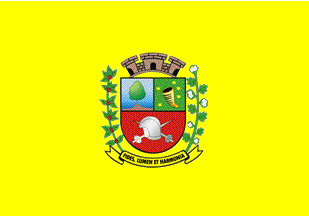
Last modified: 2013-05-15 by ian macdonald
Keywords: sao paulo | lutécia |
Links: FOTW homepage |
search |
disclaimer and copyright |
write us |
mirrors
 image by Ivan Sache, 20 April 2013
image by Ivan Sache, 20 April 2013
Lutécia was founded in 1922 by Antonio Monteiro da Silva, aka
"Mineiro", a pioneer from Piratininga. The area was rich in native
fruit trees, so that the village was originally named Frutal. The
chapel dedicated to Our Lady of Good Hope was consecrated on 25 May
1925 by Father Loughi, Vicar of Botucatu. Accordingly, the village was
renamed Boa Esperança (Good Hope). The district of Lutécia was
established by Law no. 2,380 of 11 December 1929, as part of the
municipality of Campos Novos, and transferred to the municipality of
Bela Vista (today, Echaporã), by State Decree No. 9,775 of 30 November
1938. The new name of the settlement, referring to the old name of
Paris, was coined by the State Representative Nelson Ottoni de Rezende.
The municipality of Lutétia was established by State Law-Decree No.
14,344 of 30 November 1944 and inaugurated on 1 January 1945.
http://www.lutecia.sp.gov.br - Municipal website
The flag of Lutécia is yellow with the municipal coat of arms.
Photos
http://bibliotecalutecia.blogspot.fr/2012/09/blog-post.html
http://www.portaljornalanoticia.com/products/dercilio,-peninha-e-vereadores-são-empossados-em-sessão-solene-
The coat of arms of Lutécia is "A Portuguese, rounded-off shield surmounted by a mural crown, the quarters fimbriated sable. Per fess, 1a. Azure a tree proper, 1b. Vert a cornucopia superimposed with a Southern Cross all or, 2. Gules a medieval helmet superimposed to two swords crossed per saltire all argent. The shield supported dexter by a branch of coffee and sinister by a plant of cotton. Beneath the shield a scroll or inscribed with the motto 'FIDES, LUMEN ET HARMONIA' in letters sable".
The tree means that Lutécia, with its roots in the Paulista rich
subsoil, grows in serenity and security towards a happy reality.
The green field and the cornucopia recall that the wealth and the
prosperity of the town originate in the strength of the soil and in
the labour of the people, mostly dedicated to farm work. The Southern
Cross, which can be seen all year round from the territory of Lutécia,
recalls the Christian faith.
The red field recalls the timber wood for which Brazil was named. The
helmet in the 16th century style recalls the onset of colonization of
Brazil and the inextinguishable faith and trust to the country. The
swords, pointing upwards, represent the struggle for the highest
achievements.
Coffee and cotton are two important crops in the municipality.
The Latin motto reads "Faith, Light and Harmony".
http://www.lutecia.sp.gov.br/novo_site/index.php?exibir=secoes&ID=34
- Municipal website
Ivan Sache, 20 April 2013